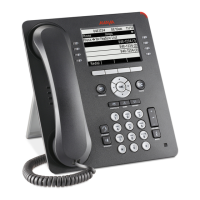Network Requirements
38 Deskphone SIP 9608, 9611G, 9621G, 9641G Administrator Guide Release 6.0.1
Displaying network audio quality
All 9600 Series SIP IP Telephones give the user an opportunity to monitor network audio
performance while on a call. The Network Information screen displays this information. Access
the Network Information screen on most 9600 Series IP button-based deskphones from the
Avaya (A) Menu and select the Network Information option directly. On touchscreen
deskphones, access the Home Screen, then select Settings, then Network Information. While
on a call, the deskphones display network audio quality parameters in real-time, as shown in
Parameters in real-time
:
Parameters in real-time
The implication for LAN administration depends on the values the user reports and the specific
nature of your LAN, like topology, loading, and QoS administration. This information gives the
user an idea of how network conditions affect the audio quality of the current call. Avaya
assumes you have more detailed tools available for LAN troubleshooting.
SIP station number portability
The 9600 Series SIP IP Telephones provide station number portability for both SES and SM
environments. With proper administration, upon startup or a reboot at a remote location within a
corporate network, the deskphone establishes communication with its home server based on
the User Name and Password. For mobile users, registration redirection occurs automatically.
For visiting users, administration is required as covered in Administering visiting users
on
page 125.
Parameter Possible Values
Received Audio Coding G.711, G.722, G.726A, or G.729.
Packet Loss No data or a percentage. Late and out-of-sequence packets are
counted as lost if they are discarded. Packets are not counted
as lost until a subsequent packet is received and the loss
confirmed by the RTP sequence number.
Packetization Delay No data or an integer number of milliseconds. The number
reflects the amount of audio data in each RTP packet.
One-way Network Delay No data or an integer number of milliseconds. The number is
one-half the value RTCP or SRTCP computes for the round-trip
delay.
Network Jitter
Compensation Delay
No data or an integer number of milliseconds reporting the
average delay introduced by the jitter buffer of the deskphone.

